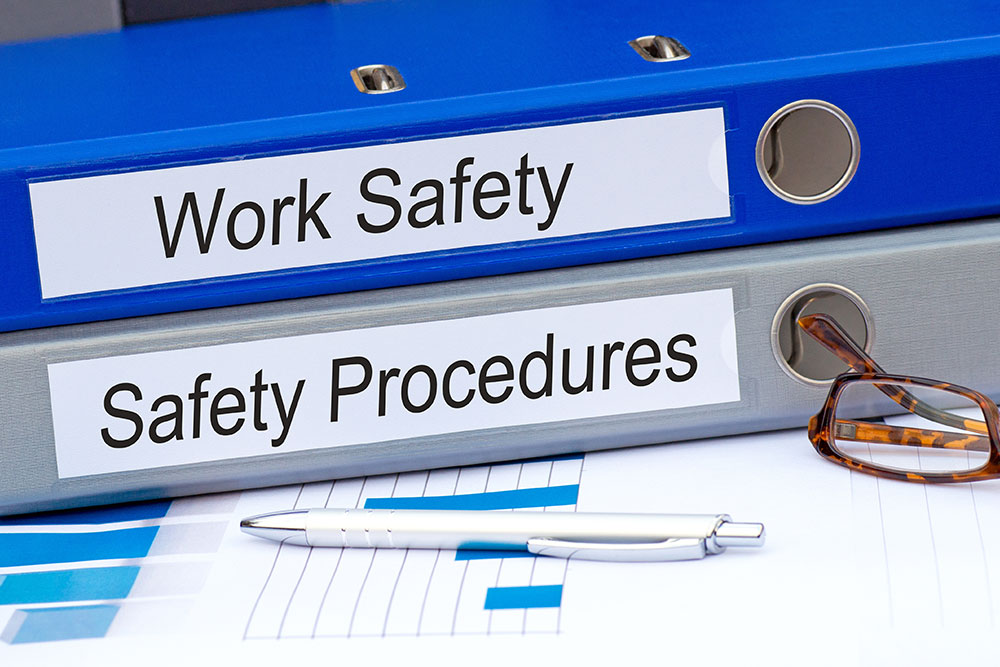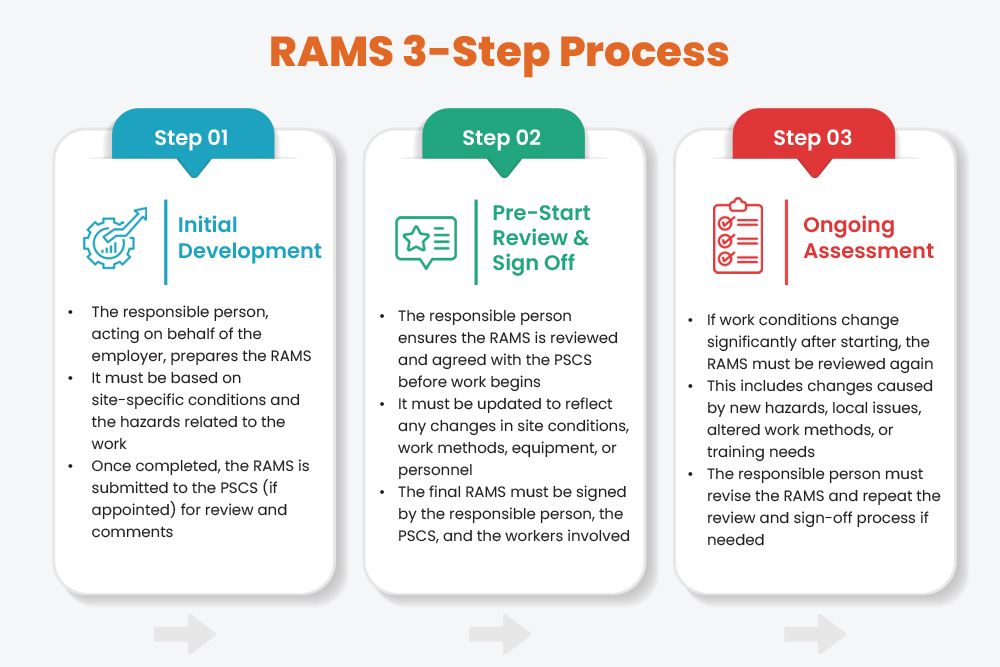
Anyone who works in the construction industry knows that there are a vast number of risks.
According to the figures from the Labour Force Survey, there was an average of 47,000 self-reported non-fatal construction injuries each year between 2021/22 and 2023/24. Of these, 33% resulted in absences lasting more than seven days.
In 2023/24 alone, employers reported 4,050 non-fatal injuries under the Reporting of Injuries, Diseases and Dangerous Occurrences Regulations (RIDDOR). These cases reflect more serious incidents, as RIDDOR reporting is only required for injuries that meet specific legal thresholds, such as fractures or amputations.
Risk Assessment Method Statements, or RAMS, are central to preventing these accidents and protecting everyone’s health and safety on construction sites.
RAMS are health and safety documents that provide in-depth information on workplace hazards. We answer the question: What are RAMS in construction and how can they prevent accidents, injuries and fatalities on construction sites?
What Are RAMS Exactly?
Have you ever heard the term RAMS used within a building project? If you have and you’re thinking of woolly creatures with horns, you’re on the wrong track.
So, what are RAMS in construction exactly? In the building game, RAMS health and safety documents are critically important.
The RAMS meaning is an acronym for Risk Assessment and Method Statement. The purpose of RAMS is to provide detailed information on workplace risks and the measures taken to control or eliminate them.
The Risk Assessment
A risk assessment identifies all the hazards in a workplace environment and the likelihood they could harm someone. The risk assessment is used to develop measures that remove or control the hazards as much as possible.
The Method Statement
Once you’ve completed a risk assessment, you must provide precise information on your risk control measures. This is your ‘method statement’, sometimes called a safe system of work document. A Risk Assessment and Method Statement (RAMS) contains more detail than a risk assessment.
A method statement includes step-by-step instructions on performing specific work duties safely to eliminate or mitigate the risks identified in the risk assessment.
A RAMS document spells out the following:
- What hazards are present
- How particular work activities can be done safely
- What control measures are in place
- How to implement the control measures
- What equipment is used
- How to use the equipment
RAMS are documents that flesh out the bare-bones findings of the risk assessment. While a risk assessment can be brief, RAMS must contain much more detail.

Is It a Legal Requirement to Have RAMS?
All UK employers have a duty of care to their employees and the public. Part of this duty is to conduct a risk assessment before any work is carried out. For construction companies, this responsibility is mandated by the Health and Safety at Work etc. Act 1974 and the Construction (Design and Management) Regulations 2015. Not conducting a risk assessment or keeping a record of it could result in criminal charges, unlimited fines and even imprisonment.
But, unlike risk assessments, companies and self-employed people aren’t legally obliged to complete RAMS. RAMS documents can still be worthwhile and are considered best practice in the construction industry, even if they’re not strictly a legal necessity.
What Are the Benefits of RAMS?
The main aim of RAMS is to help you create a safer workplace for your staff and the public. While a risk assessment will give you a broad overview of what the risks in the workplace are, RAMS go much further. RAMS provides step-by-step information on conducting work activities in the safest way possible. Once you’ve decided on a method, you can formulate it in a RAMS. RAMS also help to enhance your decision-making process.
RAMS give staff members clear step-by-step instructions to follow, so they help significantly in eliminating misunderstandings. RAMS contain guides on completing a process, so workers don’t have to waste time figuring out how to do a job properly. The RAMS guidelines also help workers avoid injury, reducing absenteeism rates.
Another benefit of RAMS is that it proves you have met your obligations under UK health and safety legislation. If there is an accident or incident, you can show that you did everything possible to avoid it.
Why RAMS Are Important in the Workplace
Generally, RAMS are used in the workplace where you can’t eliminate the risk posed by a hazard. If you’re writing a RAMS, you should include the following:
- The most up-to-date risk assessment relating to the job
- Contact information and details for all site supervisors
- Information on what equipment will be used and how
- Any other relevant information about the work
- Detailed step-by-step guides on how to complete work processes safely
Your RAMS must be distributed to all staff members and any third parties who are working on-site. You should regularly review the RAMS to ensure it’s current.
Sometimes, a Risk Assessment and Method Statement may be expressly requested by a client. It proves that a contractor understands the risks involved in the work and has taken measures to eliminate or control them. Some contractors provide RAMS to their clients, as a matter of course, to prove their professionalism.

Why Are Risk Assessments So Crucial in Construction?
Construction is one of the most hazardous industries to work in in the UK. Between 2019/20 and 2023/24, the construction sector recorded an average of 42 fatal injuries per year, as per the latest HSE statistics. If risk assessments had been conducted and followed, many deaths could have been avoided.
A case in point is the tragic death of 20-year-old Matthew Mason, who fell from a height while installing a public announcement system at Bearsden train station, East Dunbartonshire, in 2018.
The construction company Linbrooke Services Limited was found guilty of failing to correctly identify the risks associated with working at height. The company was fined £550,000 and made to pay £200,000 to the Mason family in compensation. The head of the investigation team, Debbie Carroll, stated “Matthew Mason lost his life in circumstances which were foreseeable and avoidable. His death could have been prevented had Linbrooke Services Limited put in place appropriate planning, supervision, and protective measures to manage the risk.”
How to Write a RAMS Document
RAMS documents are widely used in the construction industry to plan and carry out tasks safely. A well-written RAMS helps prevent harm by clearly setting out the risks associated with an activity and the steps needed to control them.
While not a legal requirement in the same way as risk assessments, RAMS are considered best practice, particularly for high-risk work or when requested by clients. Creating a practical and effective RAMS document typically involves the following:
Start with Project Information
Begin your RAMS by recording key project details. This sets the context and ensures the document can be referred to easily. Include:
- Project name and a brief description of the work
- Site address and location
- Client and principal contractor details
- Start and completion dates for the task
- Names of the individuals who prepared and approved the document
- Version number and date of issue
Clarity is essential when defining the scope of work. For example, “Installation of steel beams – Roof section, Zone B” is far more informative than a general description like “roofing works”.
Identify Hazards
The first section of your RAMS should contain a full risk assessment. This involves identifying all possible hazards linked to the activity. Common risks include:
- Working at height
- Use of machinery or hand tools
- Electrical work
- Exposure to hazardous substances
- Manual handling
- Hot works
- Poor weather or environmental conditions
Assess the Risk
After hazards have been identified, the next step is to assess the level of risk each one presents. Use a simple risk matrix that combines two elements:
- The severity of potential harm
- The likelihood of the harm occurring
Multiply these figures to assign a risk rating. This helps you decide which hazards need stronger control measures before work can begin.
When assessing risks, consider everyone who may be affected. This could include the workers involved, subcontractors, visitors, or members of the public nearby.
Set Out Control Measures
Once the risks have been assessed, outline the control measures that will be used to manage them. These should be structured according to the hierarchy of control:
- Eliminate the hazard if it is reasonably practicable
- Replace the risky activity, material, method or equipment with a safer alternative
- Introduce engineering controls such as guards, edge protection or isolation
- Apply administrative measures such as training, supervision and procedures
- Use personal protective equipment (PPE) only where other controls are not sufficient
Control measures must be specific. Avoid vague phrases like “use PPE” and instead provide clear instructions, such as “wear safety boots to BS EN ISO 20345 and helmets to BS EN 397.”
Following this, reassess the residual risk, which refers to the level of risk that remains after controls have been applied. If the residual risk remains too high, further controls must be introduced before work continues.
Explain the Safe Work Method
The method statement is the part of your RAMS that details how the work will be carried out. It should break the task into clear, logical steps. For each step:
- Describe the task using plain, easy-to-understand language
- Identify the person or role responsible for completing it
- List required control measures and PPE
- Note any permits, inspections or safety checks needed
Include details of pre-work checks. This could involve site setup, placing signage, inspecting tools and equipment, and holding a toolbox talk.
For more technical tasks, use visual aids such as diagrams or photographs to support the instructions.
Include Emergency Procedures
Your RAMS must include clear guidance on how to respond in an emergency.
This section should outline:
- First aid arrangements, including who’s been trained to administer first aid and the location of kits
- Evacuation procedures and where to assemble
- Emergency contact numbers for supervisors and the nearest emergency services
- Rescue procedures for tasks involving height or confined spaces
- The name and address of the nearest hospital with an accident and emergency department
Make sure all staff are briefed on these procedures before the work begins.
Final Sign-Off and Communication
Once the RAMS has been completed, it must be reviewed and approved by a competent person. This is typically a site manager or health and safety advisor.
Before work starts:
- Share the RAMS with everyone involved in the task
- Ask each team member to confirm they understand the content by signing a briefing sheet
- Keep the latest version of the RAMS accessible on site at all times
This ensures all workers know what is expected of them and how to carry out the task safely.
Keep It Updated
A RAMS should not be treated as a one-off document. It must be reviewed and updated whenever conditions change. This includes:
- A change in the task or how it is being carried out
- New or different workers joining the team
- Updates to equipment, materials or tools
- Shifts in weather or site layout
- Any accidents, near misses or safety concerns
Always treat the RAMS as a live document. When updates are made, ensure all relevant workers are re-briefed and sign to confirm they understand the changes.
Learn How to Conduct Risk Assessments and Write RAMS
Risk assessments and RAMS do more than ensure you are following the letter of the law. They save lives. Our RAMS in Construction for Frontline Employees course will teach you how to conduct a proper risk assessment and how to write and use RAMS. The knowledge gained in this course will protect your business and could help to save someone’s life.





















































































































































































































































































































































































































































































































































































































































































































































